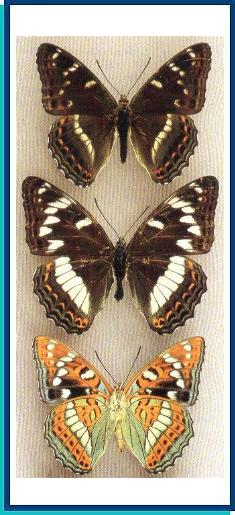LEPIDOPTERA
N Y M P H A L I D A E Swainson, 1827
LIMENITIS Fabricius, 1807
Limenitis populi Linnaeus, 1758
Limenitis populi Linnaeus, 1758

• TYPE LOCALITY. Sweden.
• RANGE. Temperate forest belt of the Palaearctic Region.
• DISTRIBUTION AND VARIATION. Numerous infrasubspecific categories have been described in this species. One of the famous forms is tremulae Esper, 1798 which has neither white spots nor bands on the UPS. The opposite extreme is a form with a very broad white band on the UPH. The following subspecies are distributed over the territories concerned: the nominotypical subspecies (= fruhstorferi Krulikowsky, 1909) - European part (except for the westernmost areas); ssp. bukovinensis Hormuzaki, 1897 - W. European part (Carpathians, W. Ukraine, Moldova); ssp. enapius Fruhstorfer, 1908 (= eumenius Fruhstorfer, 1908) - Siberia, Transbaikalia, Altais, Sayan; ssp. ussuriensis Staudinger, 1887 (= liliputana Staudinger, 1887) - Amur and Ussuri regions. All subspecies have a gradually broadening white marking on the wings and form a dine from west to east of the geographical range.
• HABITATS AND BIOLOGY. Broadleaved or mixed forests, parks, in the mountains up to the upper timber-line. Flight period: June to July. Host plants in Europe (Lang, 1884; Eckstein, 1913): Salix pentandra, S. elaeagnos; in central Russia (Dantchenko & Nikolaevsky, in press): Populus tremula; in Siberia (Korshunov & Gorbunov, 1995): Populus spp. Hibernation as instar 3 larvae in shelters built of tube-shaped leaves fastened to twigs.
Photo and text: Guide to the BUTTERFLIES OF RUSSIA and adjacent territories Volume 2. PENSOFT, Sofia - Moscow. 2000